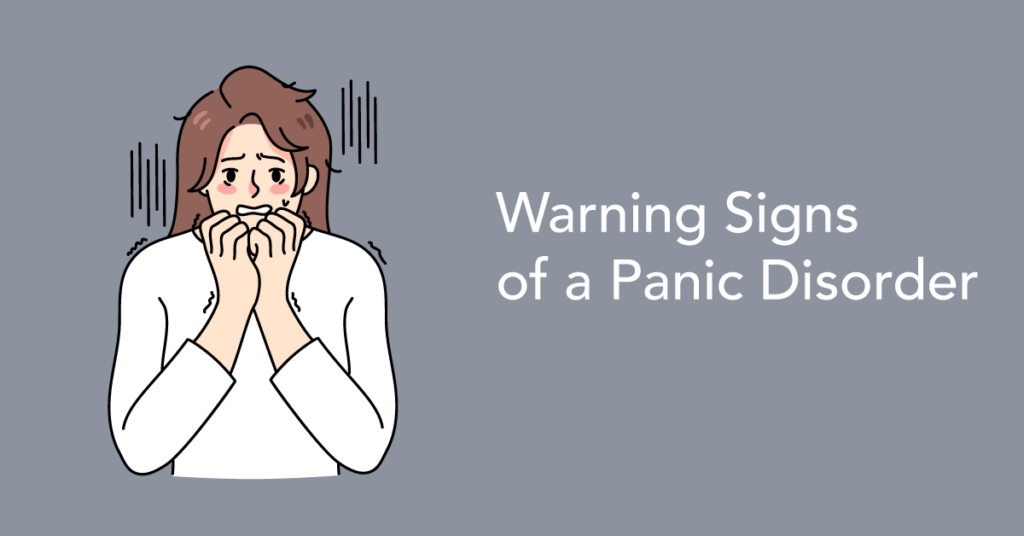Every year, 11% of people experience a panic attack, and for around 2% to 3% of Americans, these attacks are part of the symptoms of panic disorder. If you suspect you may have panic disorder, being able to recognize the warning signs of the condition will help you decide whether to seek treatment.
What Is Panic Disorder?
Panic disorder is a mental health condition marked by frequent panic attacks, which are periods of short-lived but intense physical symptoms. People with panic disorder often begin experiencing panic attack symptoms during adolescence or early adulthood, but warning signs of the condition can start at any age.
Investigation into the causes of panic disorder is ongoing, and experts still don’t fully understand why the condition develops. One popular theory is that problems with the natural stress response are responsible for panic disorder.
When you’re in a stressful situation, changes naturally take place in the body to prepare you to fight off or run from a threat. Your heart begins to beat faster. Your blood pressure rises, and you become more alert. Once the stressful situation resolves, the body returns to its normal state.
In people with panic disorder, the body’s stress response may be extra-sensitive and prone to triggering when no threat is present. Fears about experiencing future panic attacks may then leave the stress response elevated, making symptoms more likely to reoccur.
Research shows that some traits and experiences can make you more at risk for panic disorder, including:
- Being female
- Having a close family member with panic disorder
- Experiencing a stressful life event, such as loss of a job or the death of a loved one
- Having a history of trauma
- Experiencing major life changes, such as starting college or having a baby
- Smoking
- Excessive using stimulants, such as caffeine
Signs and Symptoms of Panic Disorder
Mental health care providers typically diagnose a person with panic disorder if they experience four or more panic attacks and experience worry and fear about having more attacks in the future. Panic attack symptoms include:
- Chest discomfort. During a panic attack, you may feel tightness, pressure or pain in your chest.
- Increased heart rate. You may feel the sensation of a racing heartbeat, similar to what you might experience during and after intense exercise.
- Changes in breathing. Your breathing may become faster and shallower. It may feel as if you can’t catch your breath, or you might hyperventilate.
- Shaking. Panic attacks can cause trembling confined to the hands or involving the whole body.
- Digestive issues. Nausea and diarrhea may accompany a panic attack.
- Sweating. You may begin to perspire profusely. In some cases, chills accompany sweating or occur on their own.
- Sensations in extremities. Your fingers and/or toes may tingle or go numb.
- Changes in thinking and emotions. While having a panic attack, you may feel intense fear or terror. You might feel as if you’ve lost control of your body or think you’re dying. Feeling like nothing is real or that you’re no longer connected to your body can also occur.
In most cases, panic attack symptoms come on suddenly and last for 5 to 20 minutes. Often, symptoms gradually grow worse, peaking at around 10 minutes and then slowly subsiding.
For many people with panic disorder, fear of future panic attacks becomes a constant worry. You may find yourself withdrawing from others, changing your daily routine or avoiding certain things, people or situations to avoid panic attacks.
Panic Disorder vs. Common Emotions
The warning signs of panic disorder can be similar to typical stress and anxiety, but it’s possible to differentiate the condition from these common emotions.
Panic attacks do share features with the body’s natural stress response. The main difference is that stress occurs in response to a trigger, such as a near-collision while driving, speaking in public or having an argument with someone. A panic attack can occur anytime, even when you’re at rest and otherwise relaxed.
Anxiety is another common emotion that occurs when you worry about something. When you’re experiencing anxiety, you may feel fearful or have dread. However, these feelings are usually less intense than the emotional symptoms of panic attacks. Also, panic attacks come and go quickly, while anxiety usually lasts until the stressor that caused it resolves or you become distracted by something else.
Conditions Similar to Panic Disorder
Panic attacks can occur with other mental health disorders, such as:
- Phobias
- PTSD
- Social anxiety disorder
- Obsessive-compulsive disorder
The key difference is that, with these mental health conditions, something typically triggers panic attack symptoms, but no trigger is usually present with attacks due to panic disorder.
People with generalized anxiety disorder (GAD) may experience periods of acute anxiety, known as anxiety attacks. Anxiety attack symptoms may be similar to panic attacks, but they’re usually much less intense. Also, anxiety attacks usually last for hours rather than minutes. It’s important to note that some people with GAD also have panic disorder.
Certain health conditions can also cause symptoms similar to panic attacks. For example, chest pain, shortness of breath, nausea and feelings of dread may accompany a heart attack, while difficulty breathing and acute anxiety may occur with an asthma attack. Often, symptoms that arise due to health conditions persist for longer than panic attack symptoms and may worsen without medical treatment.
Next Steps to Take
If you have panic disorder, the right treatment plan can reduce how often you experience panic attack symptoms, and the Mental Health Hotline is here to connect you with experienced providers in your area who can get you on the path to recovery. Our trained counselors are ready to assist you 24 hours per day, 7 days per week, 365 days per year. The hotline is free and completely confidential for your peace of mind. Give us a call today.


